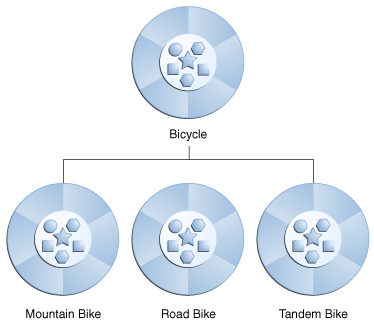Object-Oriented Programming Concepts
- classes : A class is a blueprint or prototype from which objects are created. This section defines a class that models the state and behavior of a real-world object. It intentionally focuses on the basics, showing how even a simple class can cleanly model state and behavior.
- objects : An object is a software bundle of related state and behavior. Software objects are often used to model the real-world objects that you find in everyday life. This lesson explains how state and behavior are represented within an object, introduces the concept of data encapsulation, and explains the benefits of designing your software in this manner.
- inheritance :
Inheritance provides a powerful and natural mechanism for organizing and structuring your software. This section explains how classes inherit state and behavior from their superclasses, and explains how to derive one class from another using the simple syntax provided by the Java programming language.

# Java Interfaces Tutorial In the Java programming language, an interface is a reference type, similar to a class, that can contain only constants, method signatures, default methods, static methods, and nested types. Method bodies exist only for default methods and static methods. Interfaces cannot be instantiated—they can only be implemented by classes or extended by other interfaces
Interfaces as APIs
The robotic car example shows an interface being used as an industry standard Application Programming Interface (API). APIs are also common in commercial software products. Typically, a company sells a software package that contains complex methods that another company wants to use in its own software product. An example would be a package of digital image processing methods that are sold to companies making end-user graphics programs. The image processing company writes its classes to implement an interface, which it makes public to its customers. The graphics company then invokes the image processing methods using the signatures and return types defined in the interface. While the image processing company's API is made public (to its customers), its implementation of the API is kept as a closely guarded secret—in fact, it may revise the implementation at a later date as long as it continues to implement the original interface that its customers have relied on.